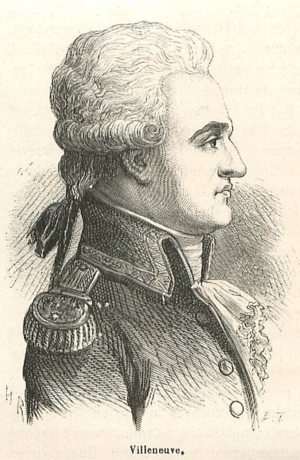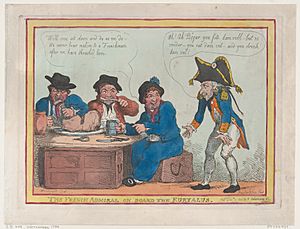Pierre-Charles Villeneuve facts for kids
Quick facts for kids
Vice Admiral
Pierre-Charles Villeneuve
|
|
|---|---|

Amiral de Villeneuve, Musée de la Marine
|
|
| Born | 31 December 1763 Valensole, Provence, France |
| Died | 22 April 1806 (aged 42) Rennes, Brittany, France |
| Allegiance | |
| Years of service | 1779–1806 |
| Rank | Vice admiral |
| Commands held |
|
| Battles/wars | |
Pierre-Charles-Jean-Baptiste-Silvestre de Villeneuve (born 31 December 1763 – died 22 April 1806) was a French naval officer. He lived during the time of the Napoleonic Wars, which were big conflicts involving France and many other European countries. Villeneuve is most known for leading the French and Spanish fleets that lost to Admiral Nelson at the famous Battle of Trafalgar.
Contents
Villeneuve was born in 1763 in a place called Valensole, in France. He joined the French Navy when he was just 16 years old in 1779. He took part in some naval battles during the American Revolutionary War. He served on a ship called Marseillais.
Even though he came from a noble family, he supported the French Revolution. This was a time when many nobles were removed from power. Because he supported the revolution, he was able to keep his job in the Navy. He even dropped the "de" from his name, which showed his noble background. He fought in several battles and was promoted to rear admiral in 1796.
At the Battle of the Nile in 1798, Villeneuve was in charge of the ships at the back of the French fleet. His ship, Guillaume Tell, was one of only two large French warships that managed to escape the battle. The British won a big victory there. Soon after, he was captured when the British took the island of Malta. But he was released not long after. Some people criticized him for not fighting harder at the Nile. However, Napoleon thought he was "lucky" and his career continued.
In 1804, Napoleon was planning to invade Britain. He ordered Villeneuve, who was now a vice admiral stationed at Toulon, to break through the British blockade. His mission was to clear the way for the invasion fleet in the English Channel. To do this, Villeneuve was supposed to sail to the West Indies. There, he would meet up with the Spanish fleet and another French fleet. Together, they would attack British lands in the Caribbean. After that, they would sail back across the Atlantic. Their goal was to destroy the British ships in the Channel and help Napoleon's army cross to England.
The Trafalgar Campaign
Preparing for Battle
After a failed attempt in January, Villeneuve finally left Toulon on March 29, 1805. He had eleven large warships. He managed to get past Nelson's blockade. Then, he sailed through the Strait of Gibraltar on April 8 and crossed the Atlantic Ocean. Nelson's fleet was chasing him, but they were about a month behind because of bad winds.
In the West Indies, Villeneuve waited for a month at Martinique. But the other French fleet he was supposed to meet never showed up. French army officers pressured Villeneuve to start attacking the British. He only managed to recapture a small island fort called Diamond Rock near Martinique. On June 7, he found out that Nelson had arrived in the area.
On June 8, Villeneuve's fleet caught a group of 15 British merchant ships heading home. These ships were protected by two British warships. The two British warships escaped, but Villeneuve's fleet captured all the merchant ships. These ships were worth a lot of money. Villeneuve then sent the captured ships to Guadeloupe. On June 11, Villeneuve set sail for Europe, with Nelson still following him.
Meeting the British Fleet
On July 22, Villeneuve's fleet, which now had twenty large warships and seven smaller frigates, passed Cape Finisterre in Spain. Here, he met a British fleet of fifteen large warships led by Vice Admiral Sir Robert Calder. In the battle that followed, called the Battle of Cape Finisterre, the weather was bad and it was hard to see. Even though the British were outnumbered, they managed to capture two Spanish ships.
For two days, Villeneuve followed the retreating British ships. But he did not try to fight them again. Instead, he sailed to A Coruña, arriving on August 1. Here, he received new orders from Napoleon. He was told to sail to Brest and Boulogne as originally planned. However, Villeneuve decided to sail back to Cádiz instead. He might have believed a false report about a larger British fleet in the area. This decision made Napoleon's plan to invade Britain impossible.
The Battle of Trafalgar
At Cádiz, the combined French and Spanish fleets were blocked by Nelson's ships. In September, Villeneuve was ordered to sail to Naples and attack British ships in the Mediterranean Sea. But he did not want to move at first and ignored these orders.
In mid-October, Villeneuve learned that Napoleon was going to replace him as commander. Napoleon was very unhappy with Villeneuve's actions. He had written that Villeneuve "does not possess the strength of character to command a frigate." Before his replacement could arrive, Villeneuve gave the order to sail on October 18.
It took two days to get all 34 ships out of port and into some kind of battle formation. This was because the crews were not very experienced. On October 21, 1805, Villeneuve found out how big the British fleet was. He tried to turn back to Cádiz. But Nelson's fleet intercepted the combined fleets off Cape Trafalgar. Nelson, even though he had fewer ships, won the famous Battle of Trafalgar. Villeneuve's main ship, Bucentaure, was captured along with many other French and Spanish ships.
After the Battle
The British sent Villeneuve to England on a ship called the Euryalus. He was later released on parole, which meant he promised not to fight again. During this time, he lived in a town called Bishop's Waltham in England. He stayed at a local inn, and his 200 men stayed in houses nearby. He was even allowed to attend the funeral of Lord Nelson, who had died during the Battle of Trafalgar.
Villeneuve was freed in late 1805 and returned to France. He tried to rejoin the military, but his requests were not accepted.
On April 22, 1806, Villeneuve was found dead in a hotel in Rennes, France. He had left a letter for his wife. Many people suspected that Napoleon had secretly ordered Villeneuve to be killed.
Legacy
Villeneuve's name is carved into the Arc de Triomphe in Paris. This famous monument honors many important French military leaders.
See also
 In Spanish: Pierre Charles Silvestre de Villeneuve para niños
In Spanish: Pierre Charles Silvestre de Villeneuve para niños


